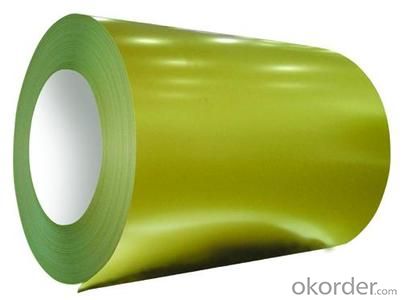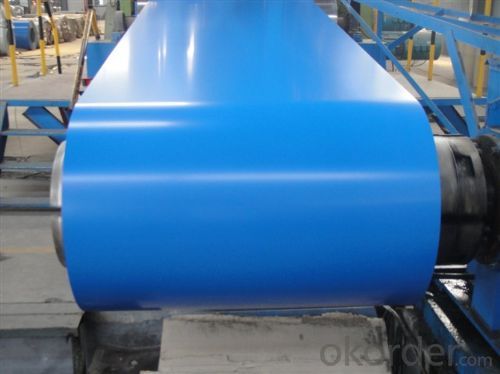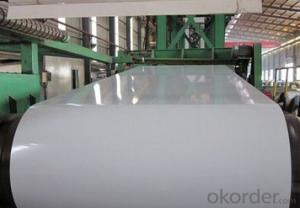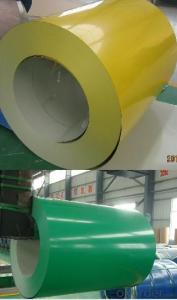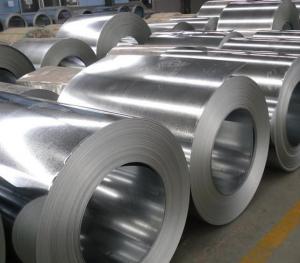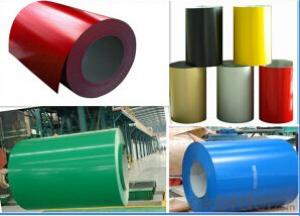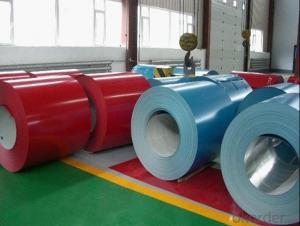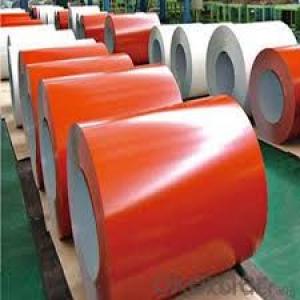Pre-Painted Galvanized Steel Coil,PPGI,PPGL Coil,Color Coated Coil
- Loading Port:
- Tianjin
- Payment Terms:
- TT OR LC
- Min Order Qty:
- 50 m.t.
- Supply Capability:
- 10000 m.t./month
OKorder Service Pledge
OKorder Financial Service
You Might Also Like
1. Pre-Painted Galvanized/Aluzinc Steel Coil Description:
With GI as base material, after pretreatment (degrease and chemical treatment ) and liquid dope with several layers of color, then after firing and cooling, finally the plate steel is called pre-painted galvanized (aluzinc) steel. Pre-painted galvanized steel is good capable of decoration, molding, corrosion resistance. It generally displays superior workability, durability and weather resistance.
2.Main Features of the Pre-Painted Galvanized/Aluzinc Steel Coil:
• Excellent process capability
• Smooth and flat surface
• Workability, durability
• Excellent heat resistance performance
• High strength
• Good formability
• Good visual effect
3.Pre-Painted Galvanized/Aluzinc Steel Coil Images
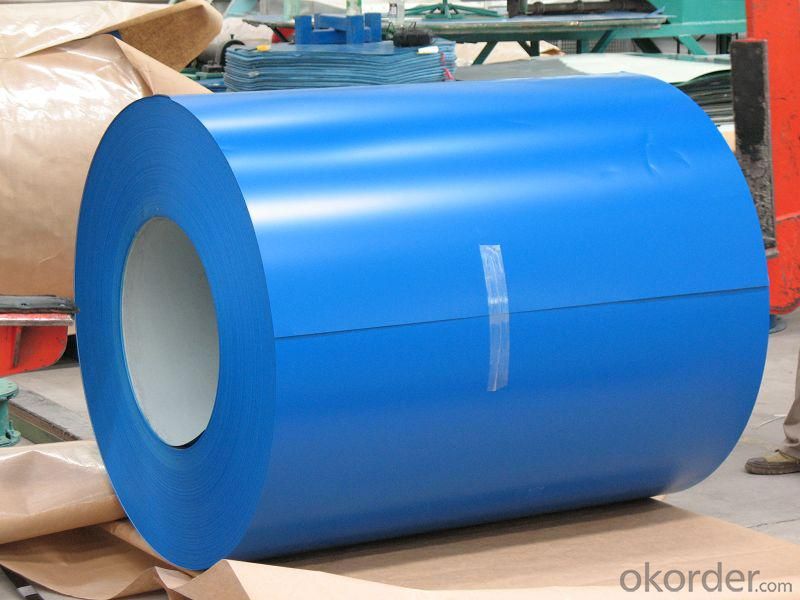
4.Pre-Painted Galvanized/Aluzinc Steel Coil Specification
Standard: AISI, ASTM, BS, DIN, GB, JIS
Grade: DX51D, DX52D
Thickness: 0.17-2.0mm
Brand Name: KMRLON
Model Number: coil
Type: Steel Coil
Technique: Cold Rolled
Surface Treatment: Coated
Application: Boiler Plate
Special Use: High-strength Steel Plate
Width: 20-1250mm
Length: customized
commoidty: pre-painted galvanized steel coil
Thickness: 0.13-4.0mm
width: 20-1250mm
zinc coating: 40-180g/m2
printing thickness: top side: 20+/-5 microns, back side: 5-7 microns
color: all RAL color
surface treatment: color coated
coil weight: 4-7 tons
coil ID: 508/610mm
packaging: standard seaworthy packing
5.FAQ of Pre-Painted Galvanized/Aluzinc Steel Coil
1. What’s the application of this product?
Roof, roof structure, surface sheet of balcony, frame of window, etc.
2. What’s the brand of the paint?
We use the best brand of all of the word—AKZO.
3. How about your company?
A world class manufacturer & supplier of castings forging in carbon steel and alloy steel,is one of the large-scale professional investment casting production bases in China,consisting of both casting foundry forging and machining factory. Annually more than 8000 tons Precision casting and forging parts are exported to markets in Europe,America and Japan. OEM casting and forging service available according to customer’s requirements.
4. How to guarantee the quality of the products?
We have established the international advanced quality management system,every link from raw material to final product we have strict quality test;We resolutely put an end to unqualified products flowing into the market. At the same time, we will provide necessary follow-up service assurance.
5. How long can we receive the product after purchase?
Usually within thirty working days after receiving buyer’s advance payment or LC. We will arrange the factory manufacturing as soon as possible. The cargo readiness usually takes 15-25 days, but the shipment will depend on the vessel situation.
- Q: Want to construct a patio cover approx. 20 feet long. Only want to use a 6x6 or 8x8 post at each end. What size steel i-beam would I have to use to carry the load???
- u can buy a laminated wood beam that would hold the weight and look better but will be taller than a metal beam i dont know much about building with metal just thought id give u another idea i know other ways but would not look good on a patio good luck
- Q: what is the differance between ceramic and stainless steel headers and 4-2-1 and 4-1 and which are better for racing and should i get ceramic or stainless steel headers???? for a 98 civic
- 1) okorder ... The top two are of 4-1 design. Good luck, have fun.
- Q: What are the safety precautions to be taken while handling steel coils?
- Some safety precautions to be taken while handling steel coils include wearing appropriate personal protective equipment (PPE) such as gloves, safety glasses, and steel-toed boots to protect against potential injuries. It is important to use proper lifting techniques and equipment, such as forklifts or cranes, to avoid strains or falls. Coils should be stored on stable surfaces and secured to prevent them from rolling or falling. Additionally, workers should be trained on proper handling procedures and be aware of the potential hazards associated with sharp edges, heavy weight, and unstable loads.
- Q: my sister is making rolls and we have no idea what steel cut oats are. can someone please help with this?
- These are oat grains that are cut with steel sheers intstead of being put the a roller processing system . These are most favored for making true oat porridge . If you really hate preparing breakfast , purchase some of these . Place them in your crockpot over night with milk or water ( your choice ) add what you like raisins cranberries , nut other dried fruits turn on low . Breakfast will be ready and waiting when you get up in the morning just make the coffee or tea . My favorite is to mix in milk , shredded carrot , dried cranberries , b. walnuts and maple syrup . Note : contrary to my predecessor , these have more nutritiional value as they havenot been so heavily processed . Quick and instant oats are just a waste nutritionall speeking . Anything that must be fortified has been over processed .
- Q: Is steel framing eco friendly? Why or why not.
- Most of it is made from recycled iron and steel. You can also climb a ladder carrying a dozen steel studs far easier than you can lumber studs. It is this latter part why it is so popular in some areas.
- Q: How are steel coils used in the manufacturing of transmission systems?
- Steel coils are used in the manufacturing of transmission systems as they are shaped and formed into various components such as gears, shafts, and bearings. These components provide strength, durability, and precision to the transmission system, ensuring smooth power transfer and efficient operation of vehicles and machinery.
- Q: How are steel coils processed for different levels of hardness?
- Different levels of hardness can be attained in steel coils using a variety of methods. One common approach is heat treatment, in which the coils are heated to a specific temperature and then rapidly cooled to modify their microstructure and achieve the desired hardness. The heat treatment process can encompass quenching, tempering, or annealing, depending on the desired hardness level. Quenching involves quick cooling of the coils in a liquid medium like water or oil to achieve a high hardness level. On the other hand, tempering requires reheating the coils to a lower temperature and gradually cooling them to attain a desired balance between hardness and toughness. Annealing, on the other hand, involves heating the coils to a specific temperature followed by slow cooling to release internal stresses and obtain a softer and more malleable material. Additionally, mechanical processes like cold rolling or cold working can be employed to enhance the hardness of steel coils. These processes involve applying compressive forces to the coils, causing the material to deform and resulting in increased hardness. Overall, achieving different hardness levels in steel coils requires meticulous control of temperature, cooling rate, and mechanical forces to obtain the desired properties for specific applications.
- Q: Can steel coils be perforated?
- Yes, steel coils can be perforated. Perforation is the process of creating small holes or punctures in a material, and steel coils can undergo this process to achieve specific purposes such as enhancing ventilation, improving drainage, or creating decorative patterns.
- Q: I was wondering because i just watched an episode of build it bigger on the discovery channel about the uss George bush, and when they were discribing it they said it was 500 tons of steel and 47,000 tons of aluminum. this kinda struck me as odd because i thought that it was mostly made of steel. and i would think that even if it was mostly aluminum, that the hull would be steel. and i think the hull would weigh more than 500 tons.
- The hull is steel the island is an aluminum composite. Carriers are 100,000 tons of Diplomatic Diplomacy!
- Q: With the Reduced weight of steel,wouldn't the projectile be at a much higher velocity when fired causing more damage?I mean l couldn't steel be worked to seal the bore,not damage the rifling and still cheap enough to mass produce,and be light enough to carry much more ammo.
- The bullet needs to be a bit malleable to conform to the grooves in the barrel. In an American .30 gun a .308 bullet is forced out of the gun it has to conform to the .30 bore and .308 grooves to form a tight seal. That's why lead and copper are the primary materials of the bullet. A steel bullet in a steel bore would potentially produce a pipe bomb or at least do significant damage to the bore. Also, the weight of bullets are optimized for their application with the current materials. There is no need or desire to reduce the mass of the bullet. Simply reducing mass for increased velocity can effect the terminal ballistics in all kinds of ways, but you cannot assume that damage will be higher for a variety of reasons. If nothing else the fact that the military has INCREASED the 5.56x45mm from 55gr to 62gr should be enough to doubt your claim. Also steel is about 70% the density of lead, so there would not be a major savings in mass, but aluminum is only 25% the density and it is much closer to the hardness of lead. If you really wanted a light bullet, the aluminum may be the way to go.
Send your message to us
Pre-Painted Galvanized Steel Coil,PPGI,PPGL Coil,Color Coated Coil
- Loading Port:
- Tianjin
- Payment Terms:
- TT OR LC
- Min Order Qty:
- 50 m.t.
- Supply Capability:
- 10000 m.t./month
OKorder Service Pledge
OKorder Financial Service
Similar products
Hot products
Hot Searches
Related keywords




